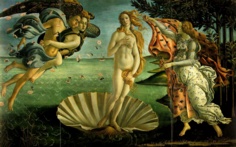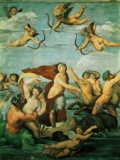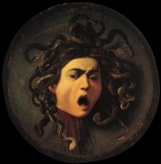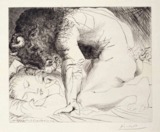

Examples of art depicting mythological subjects:

Greece, Statuette of a man and centaur, c. 750
BCE,
Geometric, bronze, height
4 3/8 inches (11.10 cm), Metropolitan Museum of Art, NY.
Attic Greek, Berlin Painter, Red-figured Hydria Depicting Apollo Riding over the Sea, 500-480 BCE, red-figure painted terra cotta, height 58 cm, Vatican. The god Apollo is seated on a winged tripod, riding over the sea (hyperpontios), which is denoted by fish and an octopus. Two dolphins leaping over the waves accompany him. Apollo plays the lyre. The Berlin Painter got his name after an amphora in Berlin that ranks among his major works. See Apollo.
![]()
Greek, South Italy, 425-400 BCE,
Cult Statue of Aphrodite, limestone
and marble, height
7 feet 6 inches (220 cm), J. Paul Getty Museum, Malibu, CA.
Hellenistic Greek, Samothrace (island in the North Aegean Sea), c. 190 BCE, Nike on the Prow of a Ship, called the "Winged Victory of Samothrace", gray Lartos marble for the ship's prow, white Paros marble for the statue, height 3.28 m (floor to top of wings) (10 feet 9 inches), Louvre. See Hellenistic and Nike.
![]()
Roman, after the School of Polykleitos, c.
CE
125, Statue of the Lansdowne Herakles (Hercules),
marble, height
76 3/16 inches (193.5 cm), J. Paul Getty Museum, Malibu, CA
Note the 1150 year gap here.

Sandro Botticelli (Italian, 1444-1510), Birth of Venus, c. 1485, tempera on canvas, (172.5 x 278.5 cm), Uffizzi Gallery, Florence.

Lucas Cranach the Elder (German, 1472-1553),
Venus and Cupid, 1509, oil
on canvas (transferred
from panel), 84 x 40 inches (213 x 102 cm), Hermitage Museum,
St. Petersburg, Russia.

Michelangelo (born Michelangiolo Buonarroti)
(Italian, 1475-1564), Bacchus, 1496-97, marble, height
(with base) 6 feet 7 5/8 (195 cm), statue (without base) 6 feet
3/8 inch, Museo Nazionale del Bargello, Florence. There is a little Faun (or Satyr) eating grapes from a
panther skin which Bacchus holds in his left hand. This work
was carved in Rome, in 1496, for the collector Jacopo Galli.
See satyr.

Raphael Sanzio (Italian, 1483-1520), The Nymph Galatea, c. 1512-14, fresco, 116 x 88 1/2 inches (295 x 225 cm),
Villa Farnesina, Rome.

Titian (Tiziano Vecellio) (Italian, 1488/90-1576),
Danae, 1546/53, oil
on canvas, 47 x 73 1/2
inches (120 x 187 cm), Hermitage Museum, St. Petersburg, Russia.

Titian and Workshop, Venus and the Lute Player, c. 1565-70,
oil on canvas,
65 x 82 1/2 inches (165.1 x 209.6 cm), Metropolitan Museum of
Art, NY. (On the Met's page, you can enlarge any detail.)
![]()
Johan Gregor van der Schardt (Dutch, 1530-
about 1580), Mercury, Bologna, Italy, 1570-1580, bronze, height
45 1/4 inches (115 cm), J. Paul Getty Museum, Malibu, CA. Both
Giambologna and Van der Schardt have given Mercury several attributes that signify
his speediness: his sandals and hat bear wings. The caduceus
he carries remind us of Mercury's role as patron of science.
![]()
Attributed to Benedikt Wurzelbauer (German,
1548-1620), Neptune, about 1600 - 1620, bronze,
height 24 1/2 inches (62
cm), J. Paul Getty Museum, Malibu, CA.

Caravaggio (Italian, 1573-1610), Medusa, oil
on a circular convex
leather shield, diameter
55.5 cm, Uffizi Gallery, Florence. See Baroque, Caravaggisti,
and snake.
Guido Reni (Italian, 1575-1642).

Peter Paul Rubens (Flemish, 1577-1640), Bacchus, 1638/40, oil
on canvas (transferred
from panel), 75 x 63 1/2 inches (191 x 161.3 cm), Hermitage Museum,
St. Petersburg, Russia.

Peter Paul Rubens (Flemish, 1577-1640), The Three Graces, oil
on wood panel,
(221 x 181 cm), Prado Museum, Madrid.
Antoon [Anthony] Van Dyck (Dutch, 1599-1641)
Diego Velázquez de Silva (Spanish, 1599-1660).

Giovanni Benedetto Castiglione, called Il
Grechetto (Italian, 1609-1664), Youth Playing a Pipe for a Satyr, 1650s,
brush with colored
oil paint, paper
partly saturated with oil; lined, 16 1/16 x 21 1/8 inches (40.8
x 53.6 cm), Metropolitan Museum of Art, NY.

François Boucher (French, 1703-1770),
The Toilet of Venus, 1751, oil
on canvas, 42 5/8 x 33
1/2 inches (108.3 x 85.1 cm), Metropolitan Museum of Art, NY.
(On the Met's page, you can enlarge any detail.) See Rococo.

Sir Joshua Reynolds (English, 1723-1792),
The Infant Hercules Strangling the Serpents,
c. 1786/88, oil on canvas, 119 x 117 inches (303
x 297 cm), Hermitage Museum, St. Petersburg, Russia.

Anton Raffael Mengs (German, 1728-1779),
Perseus and Andromeda, 1777, oil
on canvas, 227 x 153.5
cm, Hermitage Museum, St. Petersburg, Russia.

Francisco de Goya y Lucientes (Spanish, 1746-1828),
Saturn
Devouring one of his Sons, mural
transferred to canvas,
(146 x 83 cm), Prado Museum, Madrid. See grotesque
and Romanticism.
![]()
Claude Michel, "Clodion" (French,
1738-1814), Vestal Presenting a Young Woman at the Altar
of Pan, about 1770-1775, terra
cotta, height excluding
base 17 3/4 inches (45
cm), J. Paul Getty Museum, Malibu, CA.
Jacques-Louis David (French, 1748-1825), Cupid and Psyche, 1817, oil on canvas, Cleveland Museum of Art.

Gustave Moreau (French, 1826-1898), Oedipus and the Sphinx, 1864, oil
on canvas, 81 1/4 x 41
1/4 inches (206.4 x 104.8 cm), Metropolitan Museum of Art, NY.
See sphinx and Symbolism.
Frederick William MacMonnies (American, 1863-1937), Bacchante and Infant Faun, 1893-1894 (this cast, 1894), bronze, 84 x 29 3/4 x 31 1/2 inches (213.4 x 75.6 x 80 cm), Metropolitan Museum of Art, NY.

Lewis W. Hine (American, 1874-1940), Icarus
Atop Empire State Building, c. 1931, photograph,
George Eastman House, Rochester, NY.

Pablo Picasso (Spanish, 1881-1967), Minotaur
Caressing a Sleeping Woman, 1933, drypoint, from the edition
of 303, 11 5/8 x 14 1/2 inches (29.6 x 36.7 cm), San Diego Museum
of Art, CA. See labyrinth.

Giorgio de Chirico (Italian, 1888-1978),
Ariadne, 1913, oil
and graphite on canvas,
53 3/8 x 71 inches (135.6 x 180 cm), Metropolitan Museum of Art,
NY. See Metaphysical Painting.

Jacques Lipchitz (Lithuanian born, became
a French citizen 1925, an American citizen 1958, 1891-1973),
Bellerophon Taming Pegasus: Large Version,
1964-66, bronze,
edition 1/2, 179 1/2 x
134 x 59 inches, Kemper Museum of Contemporary Art, Kansas City,
MO.
Audrey Flack (American, 1931-), Hannah:
Who She Is, 1982, acrylic
and oil on canvas,
84 x 60 1/4 inches, National Museum of women in Art, Washington,
DC.
Also see Apollo, Baroque, colossus and colossal, encaustic, genres, muses, Prometheus, satyr, and statue.
https://inform.quest/_art